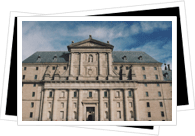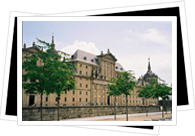El Escorial, Spain
 One of the easiest and most popular day trips from Madrid is to the Escorial palace and nearby Valle de los Caídos. If you're interested in 16th century and/or post Civil War Spain, this is an historical journey worth taking.
One of the easiest and most popular day trips from Madrid is to the Escorial palace and nearby Valle de los Caídos. If you're interested in 16th century and/or post Civil War Spain, this is an historical journey worth taking.
About El Escorial
Construction on El Escorial began just one year after Phillip II moved his court to Madrid, in 1562. The vast complex served as palace, monastery, library and mausoleum, from which Phillip II and his successors ruled the ever-expanding Spanish Empire during the 16th, 17th and early 18th centuries.
 El Escorial's architecture reflects Phillip II's austere religiosity and the Renaissance fashion of the times. It is a long, rectilinear structure with little-to-no exterior adornment. The principal architects, Juan de Herrera and Juan de Bautista de Toledo, bestowed it grey slate turrets that would come to define Hapsburg-era architecture in Madrid.
El Escorial's architecture reflects Phillip II's austere religiosity and the Renaissance fashion of the times. It is a long, rectilinear structure with little-to-no exterior adornment. The principal architects, Juan de Herrera and Juan de Bautista de Toledo, bestowed it grey slate turrets that would come to define Hapsburg-era architecture in Madrid.
El Escorial is divided into many interesting sections: library, palace/residence, basilica, battle hall, royal pantheon, gardens, reliquary... though if you're interested in artwork, the Prado Museum now holds most of El Escorial's former gems. For example, Bosch's masterpiece, "The Garden of Earthly Delights," used to hang in Phillip's bedroom.
Getting to El Escorial
El Escorial is located about 45 km (28 miles) northeast of Madrid. By car, take Autovia 1 (A-V1) to M-600.
Train: Take Cercanías line C-8 from the Atocha train station approx. 1 hour to the El Escorial stop.
Bus: With the company "Autocares Herranz," # 664 or 661 from the "Intercambiador de Moncloa"
El Escorial Hours & Rates
El Escorial closes on Mondays. The Palace & Monastery are open 10am-5pm from Oct-March and 10am-6pm,
April - September.
Combined ticket El Escorial + El Valle de los Caídos
Includes guided visit at El Escorial + unguided visit at El Valle de los Caídos
